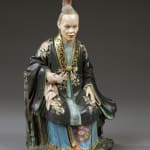Pair of Chinese Export Painted Clay Nodding Figures
31 x 18 x 13 cm
Further images
Provenance
Private Collection, France
With Jeremy Ltd. (London) in 2000
Private Collection, Florida
Polychrome decorated terracotta figures of a mandarin and his female consort, retaining most of their original paint.
The male figure is seated on rockwork and wears a bright yellow robe decorated with floral sprays; he retains his original beard and wears an official’s hat. The female figure is also seated on rockwork and is dressed in a dark blue robe; she has a tied hairstyle and wears pendent cut glass earrings.
Oriental artefacts were immensely popular in the 18th century. Export goods from the Far East included china, lacquerware and figures like these, which were highly prized and perceived as very exotic. A painting by John Zoffany depicting Queen Charlotte at her dressing table at Hampton Court in the mid 1760s shows a Chinese ‘nodding head’ figure behind her, and at the Swedish royal court Chinese ‘nodding head’ figures are mentioned in 18th century inventories of Drottningholm Palace. Most of these figures, like the ones in the Zoffany painting, are in a standing position; seated figures such as the present pair are extremely rare.
The fashion for chinoiserie or the “Chinese taste” swept through Europe in the 18th century, and influenced all areas of interior (and exterior) decoration from furniture to pictures and decorative objects. Chinese “nodding head” figures were found in many of the Royal palaces; notably in the Chinese Pavilion at Drottningholm Palace, the largest residence of the Swedish Royal Family near Stockholm, which was a birthday present to Queen Lovisa Ulrica from her husband King Adolph Frederick in 1753. In Setterwall, Fogelmarck and Gyllensvärd, The Chinese Pavilion at Drottningholm, 1972, there are illustrations of several figures in this important collection. A very fine pair of painted clay figures of a mandarin and his wife is illustrated on page 181.
Buckingham Palace has a painting by Johann Zoffany, circa 1765, of Queen Charlotte at her dressing table. Queen Charlotte is pictured with the young Prince of Wales and Prince Frederick; in the background are two Chinese mandarin figures, similar to the mandarin figure of the pair described above, although standing as opposed to seated. This picture is illustrated in Harris, de Bellaigue and Millar, Buckingham Palace and its Treasures, 1968, page 226, and in Percy Macquoid & Ralph Edwards, The Dictionary of English Furniture, Vol II, 1927, page 351.
Chinese figures were also part of the decoration at the Royal Pavilion, Brighton, so much so that "nodding head" figures are often referred to as "in the manner of the Brighton Pavilion". A pair of such figures is illustrated in John Morley, The Making of the Royal Pavilion Brighton, 1984, page 176, fig. 182, in a design for 'The Corridor by Augustus Pugin'. A closely related Chinese “nodding head” figure of a lady was recently exhibited in 'A Tale of Three Cities: Canton, Shanghai & Hong Kong', Sotheby’s London, January 1997, cat. no. 190. The catalogue entry states that the painted figure “is one of a series of ‘mandarin’ figures with mobile weighted heads which were in place in the corridor of the Prince Regent’s Pavilion at Brighton by 1815. In 1847-8 they were removed, together with the rest of the contents of the Pavilion, to Buckingham Palace.






